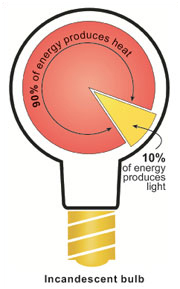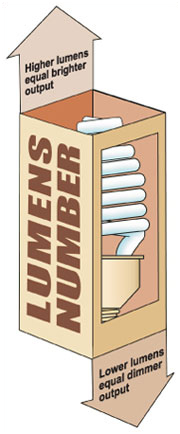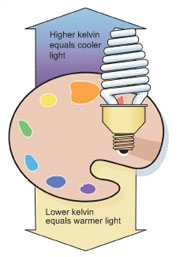Some consumers are stockpiling incandescent bulbs while the phase-out of out energy-inefficient incandescent light bulbs continues. Even though Congress recently eliminated funding for enforcement of minimum efficiency standards for new light bulbs, incandescent bulbs will probably disappear from store shelves eventually. Light bulb manufacturers have already invested millions of dollars retooling their production lines to make more efficient bulbs.
Fast way to cut home energy costs

Making improvements to your lighting is one of the fastest ways you can cut your home energy costs. According to the U.S. Department of Energy, 11 percent of the average household’s energy costs are spent on lighting. In general, incandescent bulbs use only 10 percent of the energy consumed to light the lamp. The other 90 percent of the energy consumed produces heat generated by the incandescent bulb. Generally, the most energy-efficient types of home lighting are fluorescent and light emitting diodes (LEDs).
New packaging labels can help you select the best products for specific uses. By reviewing the label information, you can determine the estimated yearly energy costs, watts used, brightness and light appearance. You can also look at the label and easily compare the color temperature, or Kelvin, of the bulbs, and be able to determine if the lamp appearance will be warm or cool. Also look for the Energy Star label on the packaging. Products with the Energy Star label have met increased energy efficiency product requirements.
Match the lighting function to each room
Some rooms need different types of lighting. You should match the intended function of the space with the light source.


How to measure brightness
If brightness is important, compare the lumens of two or more products. The higher the lumens, the brighter the light output. Once you have found bulbs that provide the desired lumens, choose bulbs with the lowest watts, if your goal is to save energy costs. The more lumens produced by a bulb per watt (energy used), the more efficient the light bulb is and the more energy is saved.
How to measure color of light
The color of the light is measured by a temperature scale called the Kelvin (K) scale. The scale typically ranges from 1,500K to 9,000K. The lower the Kelvin number, the warmer the light will appear. The higher the Kelvin, the cooler, or more blue, the light will appear. For example, if you are comparing two bulbs and one is listed at 2,700K and the other one is 4,000K, and you desire a warmer light, select the one with 2,700K.
The color rendering index (CRI) measures how true a light source reveals the appearance of colored objects. The index range is from 0 to 100. The higher the CRI, the better the color-rendering ability of the bulb. When color accuracy is important, use a bulb with an 80 CRI or higher. Not all consumer packages will include the CRI. However, the information is available through manufacturers.
Replacing incandescent bulbs with the more energy-efficient lamps can be expensive. A good suggestion is to identify your four or five most used lamps or those that are on for several hours each day. Replace them with Energy Star-qualified bulbs. As your budget allows, replace more bulbs with energy-efficient alternatives.
For more information on home lighting, contact your local University of Missouri Extension center.